Manifesto
Reasons
Reasons
Until a few decades ago, most children in Spain, both in towns and cities, were able to walk to school and use the streets to play, unaccompanied by adults. Today, this autonomy of movement has been drastically reduced by an urban model that prioritises mobility in private vehicles, which has a number of implications for children’s lives, development and health.
In addition to the safety consequences, it is necessary to make visible another set of impacts on air quality and public space that affect children’s development and health.

INSECURITY
Concerned about the safety of their children, many families now do school runs, aggravating traffic congestion around schools and generating a vicious circle that is difficult to break: more cars, more risk, fewer children on foot, more cars, more risk, fewer children on foot…
Car-dominated roads are detrimental to children’s safety and autonomy. Traffic accidents continue to be one of the leading causes of death in children under 15 years of age. In recent years, as many as 1,800 children of this age have been involved in urban pedestrian-vehicle crashes in recent years. In Spain, 12 pedestrians younger than 15 years were involved in a fatal urban traffic accidence between 2019 and 2022 [1].
TRAFFIC INDISCIPLINE
The school environment typically fails to provide good examples of compliance with traffic rules. During school start and finish times, there are often double queues, parking on pavements and pedestrian crossings, and other risky behaviours due to road congestion, rush, and permissiveness from local authorities. These behaviours pose a real risk to pedestrians and cyclists.
DIFFICULTY IN PLAYING AND TRAINING
MATURITY AND AUTONOMY
The perception of danger has led to overprotection and constant adult control of childhood, preventing the learning and mastery of many skills that are essential for good physical development and the maturation of basic psychological skills: social skills, problem solving, spatial orientation, sense of efficacy, self-care, self-confidence, etc.
Children’s and young people’s difficulties in walking, running and interacting with their immediate environment, as well as in meeting and playing
The perception of danger has led to overprotection and constant adult control of childhood, preventing the learning and mastery of many skills that are essential for good physical development and the maturation of basic psychological skills: social skills, problem solving, spatial orientation, sense of efficacy, self-care, self-confidence, etc.
freely with peers, have been linked not only to a lack of autonomy, but also to increasing problems of loneliness and isolation, or to increased emotional stress and hyperactivity.
Such is the importance of play to children that it is recognised as one of their fundamental rights by the Convention on the Rights of the Child, which also states that “society and public authorities shall endeavour to promote the enjoyment of this right“.
Children’s and young people’s difficulties in walking, running and interacting with their immediate environment, as well as in meeting and playing freely with peers, have been linked not only to a lack of autonomy, but also to increasing problems of loneliness and isolation, or to increased emotional stress and hyperactivity.
Such is the importance of play to children that it is recognised as one of their fundamental rights by the Convention on the Rights of the Child, which also states that “society and public authorities shall endeavour to promote the enjoyment of this right“.
PHYSICAL ACTIVITY, OBESITY AND SOCIAL INTERACTION
Spain has one of the highest obesity rates in Europe. Approximately 40% of children are overweight. Of these 19% are boys (almost 1 in 5) and 17% are girls.[2] The risk of childhood overweight and obesity is influenced by interactions between genes, lifestyle habits, and physiological and social factors. It is also increased by exposure to environmental factors, such as air pollution [3]. According to a study published in 2022, the respective number of overweight and obese children in Barcelona would be reduced by 1,468 and 3,094 each year if the city met the thresholds for particulate matter and nitrogen dioxide specified in the World Health Organization (WHO) 2021 global air quality guidelines [4].
Childhood obesity has both immediate and long-term effects on physical, social, and emotional health. Obese children and adolescents are at an increased risk of other chronic health conditions, such as asthma, sleep apnoea, bone and joint problems, type 2 diabetes, and heart disease. They are also more prone to social isolation, depression,
Spain has one of the highest obesity rates in Europe. Approximately 40% of children are overweight. Of these 19% are boys (almost 1 in 5) and 17% are girls.[2] The risk of childhood overweight and obesity is influenced by interactions between genes, lifestyle habits, and physiological and social factors. It is also increased by exposure to environmental factors, such as air pollution [3]. According to a study published in 2022, the respective number of overweight and obese children in Barcelona would be reduced by 1,468 and 3,094 each year if the city met the thresholds for particulate matter and nitrogen dioxide specified in the World Health Organization (WHO) 2021 global air quality guidelines [4].
Childhood obesity has both immediate and long-term effects on physical, social, and emotional health. Obese children and adolescents are at an increased risk of other chronic health conditions, such as asthma, sleep apnoea, bone and joint problems, type 2 diabetes, and heart disease. They are also more prone to social isolation, depression, and low self-esteem. Less active children in general have a higher prevalence of emotional and psychological disorders (Ministerio de Sanidad) [5]. Sport and exercise help children acquire social skills, offering them a flexible environment in which they can interact with different kinds of people and actively explore skills such as teamwork, problem solving, and goal setting [6].
and low self-esteem. Less active children in general have a higher prevalence of emotional and psychological disorders (Ministerio de Sanidad) [5]. Sport and exercise help children acquire social skills, offering them a flexible environment in which they can interact with different kinds of people and actively explore skills such as teamwork, problem solving, and goal setting [6].
Childhood overweight is closely linked to a sedentary lifestyle and the difficulties that children have meeting minimum recommendations for daily exercise, which should include active travel to and from school and sport and games in their neighbourhood. The Spanish Ministry of Health recommends a daily average of 60 minutes of moderate to vigorous exercise for children aged between 5 and 17 years. However, only about 1 in 3 children worldwide achieve this target. The overall trend is for greater screen time and lower physical exercise [7]. School is an ideal place for promoting physical activity and social skills to address sedentary behaviour and overweight.
Childhood overweight is closely linked to a sedentary lifestyle and the difficulties that children have meeting minimum recommendations for daily exercise, which should include active travel to and from school and sport and games in their neighbourhood. The Spanish Ministry of Health recommends a daily average of 60 minutes of moderate to vigorous exercise for children aged between 5 and 17 years. However, only about 1 in 3 children worldwide achieve this target. The overall trend is for greater screen time and lower physical exercise [7]. School is an ideal place for promoting physical activity and social skills to address sedentary behaviour and overweight.

CHILDHOOD EXPOSURE TO AIR POLLUTION
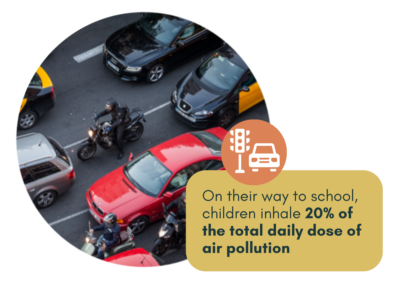
Air pollution is an invisible health threat that causes more deaths every year than traffic accidents. According to the European Environment Agency (EEA), air pollution is responsible for approximately 430 000 premature deaths in Europe a year. Children are especially vulnerable as their respiratory systems and brains are still developing. According to EEA estimates, air pollution causes 1200 premature deaths annually among children younger than 18 years in Europe [8].
People living in cities are particularly affected by air pollution, as NO2 and particulate matter with a diameter of 10 microns or less (PM10) (this includes fine [PM2.5] and ultrafine particles) are major risk factors for diseases such as respiratory infections, asthma, cardiovascular disease, and lung cancer. Approximately 33% of childhood asthma cases in Europe are attributable to air pollution [9].
Air pollution also affects cognitive health and academic performance. Both acute and chronic exposure can lead to impaired executive function, problem-solving difficulties, and an increased risk and prevalence of attention deficit hyperactivity
Air pollution is an invisible health threat that causes more deaths every year than traffic accidents. According to the European Environment Agency (EEA), air pollution is responsible for approximately 430 000 premature deaths in Europe a year. Children are especially vulnerable as their respiratory systems and brains are still developing. According to EEA estimates, air pollution causes 1200 premature deaths annually among children younger than 18 years in Europe [8].
People living in cities are particularly affected by air pollution, as NO2 and particulate matter with a diameter of 10 microns or less (PM10) (this includes fine [PM2.5] and ultrafine particles) are major risk factors for diseases such as respiratory infections, asthma, cardiovascular disease, and lung cancer. Approximately 33% of childhood asthma cases in Europe are attributable to air pollution [9].
Air pollution also affects cognitive health and academic performance. Both acute and chronic exposure can lead to impaired executive function, problem-solving difficulties, and an increased risk and prevalence of attention deficit hyperactivity disorder (ADHD). High concentrations of pollutants such as PM2.5 and NO2 in schoolyards have been linked to slower development of working memory in children between 7 and 10 years old. There is also research showing that children living in areas with high levels of PM2.5 and low green space exposure are 62% more likely to have ADHD than those living in areas with low levels of PM2.5 and high green space exposure [10].
disorder (ADHD). High concentrations of pollutants such as PM2.5 and NO2 in schoolyards have been linked to slower development of working memory in children between 7 and 10 years old. There is also research showing that children living in areas with high levels of PM2.5 and low green space exposure are 62% more likely to have ADHD than those living in areas with low levels of PM2.5 and high green space exposure [10].
Air pollution can also undermine mental health, with research showing higher rates of mental illness in people aged 18 years who grew up in an area with high levels of traffic-related air pollution [11].
A recent study of school routes and environments conducted in the city of Barcelona [12] showed that children inhale 20% of the total air pollutant dose while walking to school, even though this accounts for just 6% of their day. The rest of pollutants come from home (35%) and school (30%).
The above findings highlight the need for safe (accident-free) and healthy school routes. [13] [14]
Air pollution can also undermine mental health, with research showing higher rates of mental illness in people aged 18 years who grew up in an area with high levels of traffic-related air pollution [11].
A recent study of school routes and environments conducted in the city of Barcelona [12] showed that children inhale 20% of the total air pollutant dose while walking to school, even though this accounts for just 6% of their day. The rest of pollutants come from home (35%) and school (30%).
The above findings highlight the need for safe (accident-free) and healthy school routes [13], [14].
NOISE EXPOSURE IN CHILDREN: A DEAFENING PROBLEM NOT BEING DEALT WITH
URBAN HEAT ISLANDS
AND CLIMATE CHANGE
Noise affects our autonomic and endocrine nervous systems, leading to changes in heart rate and blood pressure and triggering the release of stress-associated hormones, such as cortisol. Several studies have detected a link between noise pollution and impaired cognitive function, hormonal disturbances (e.g., diabetes), stroke, and mental health issues such as depression and stress [15]. Exposure to road traffic noise at school has been associated with slow development of working memory and increased inattentiveness [16].
It has been estimated that noise is responsible for more than 72,000 hospitalisations and 16,600 premature deaths in Europe every year. While confirmatory studies are needed, there is also evidence suggesting that noise is a risk factor for behavioural and attention problems in children. According to the WHO, noise exposure may be one of the leading preventable causes of deafness in childhood [17].
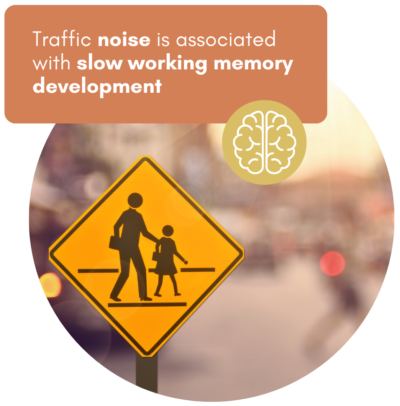
Industrial and traffic pollution, asphalt surfaces (which retain heat and prevent the natural soaking of rainwater into the ground), and densely concentrated buildings that trap heat cause pockets of heat known as urban heat islands. All these factors, together with a shortage of green spaces, such as parks and trees, and blue spaces, such as seas, rivers, ponds, and fountains, cause heat build-up that can seriously affect the health of urban populations, in particular children and older individuals. Extreme heat in classrooms can negatively affect cognitive development, concentration and focus, general performance, and working memory [18].
Numerous studies have shown that more greenery in public spaces can act as a buffer against the negative effects of extreme temperatures and reduce mortality. There is also growing evidence that urban greenery has beneficial effects on mental and cardiovascular health in the general population (due to stress reduction) and on neurodevelopment in children [17]. Studies have shown that children tend to engage in physical activity for longer and at higher intensities in green spaces, such as parks. [20] [21]
Climate change effects will add to existing challenges regarding urban climate comfort, unless we adapt buildings and public spaces to rising temperatures and ever-more common heat waves [22]. Schools in particular are generally ill equipped to provide optimal thermal comfort [18]. Many of the existing buildings are old and have deficient thermal insulation.
SOURCES
SOURCES
- [1] DGT (2022)
- [2] Iniciativa Europea de Vigilancia de la Obesidad Infantil, Organización Mundial de la Salud (OMS)
- [3] ISGlobal, “Un experimento natural muestra la relación entre contaminación atmosférica y obesidad infantil”, ISGlobal. [Online]
- [4] M. Rigau Sabadell, “Ambient air pollution, urban green space and childhood overweight and obesity: a health impact assessment for Barcelona, Spain”, Respository UPF, pp. 1–20, 2022.
- [5] S. Aznar, T. Webster, and J. López, “Actividad física y salud en la infancia y la adolescencia. Guía para todas las personas que participan en su educación,” Ministerio de Educacion y Cultura, Centro de Investigación y Documentación educativa, 2006.
- [6] J. Li and W. Shao, “Influence of Sports Activities on Prosocial Behavior of Children and Adolescents: A Systematic Literature Review”, International Journal of Environmental Research and Public Health, vol. 19, no. 11. 2022. doi: 10.3390/ijerph19116484
- [7] M. S. Tremblay et al., “Active Healthy Kids Global Alliance Global Matrix 4.0—A Resource for Physical Activity Researchers”, J Phys Act Health, vol. 19, no. 11, 2022, doi: 10.1123/jpah.2022-0257
- [8] European Environment Agency, “Air pollution levels across Europe still not safe, especially for children,” EEA . [Online]
- [9] H. Khreis et al., “Outdoor air pollution and the burden of childhood asthma across Europe”, European Respiratory Journal, vol. 54, no. 4, p. 1802194, Oct. 2019, doi: 10.1183/13993003.02194-2018
- [10] ISGlobal, “Los niños y niñas con mayor exposición a la contaminación del aire y menor exposición a espacios verdes tienen un 62% más de riesgo de padecer TDAH”, ISGlobal, 2022. [Online]
- [11] R. M. Latham et al., “Childhood exposure to ambient air pollution and predicting individual risk of depression onset in UK adolescents”, J Psychiatr Res, vol. 138, 2021, doi: 10.1016/j.jpsychires.2021.03.042
- [12] ISGlobal, Estudio BREATHE.
- [13] Gascón, M. Entorno urbano y Salud: ¿Qué ciudades queremos?
- [14] Asociación Española de Pediatría, Comité de Salud Medioambiental. Caminando al Cole. Un modelo para innovar en salud de los niñ@s y medio ambiente (2019)
- [15] Foraster, M. “El ruido: mucho más que una molestia”, ISGlobal. [Online]
- [16] M. Foraster et al., “Exposure to road traffic noise and cognitive development in schoolchildren in Barcelona, Spain: A population-based cohort study”, PLoS Med, vol. 19, no. 6, 2022, doi: 10.1371/journal.pmed.1004001
- [17] Sordera y pérdida de la audición, Organización Mundial de la Salud (OMS). [Online]
- [18] M. Ubalde, “Cuidado con los niños y niñas durante las olas de calor. ¿Qué se puede hacer en las escuelas?,” ISGlobal.
- [19] “5 claves para ciudades más saludables”, ISGlobal. [Online]
- [20] J. C. ALEJANDRE and M. LYNCH, “‘Kids Get in Shape with Nature’: A Systematic Review Exploring the Impact of Green Spaces on Childhood Obesity”, J Nutr Sci Vitaminol (Tokyo), vol. 66, no. Supplement, pp. S129–S133, 2020, doi: 10.3177/jnsv.66.S129
- [21] D. Buczyłowska, T. Zhao, N. Singh, A. Jurczak, A. Siry, and I. Markevych, “Exposure to greenspace and bluespace and cognitive functioning in children – A systematic review”, Environmental Research, vol. 222. 2023. doi: 10.1016/j.envres.2023.115340
- [22] https://twitter.com/mitecogob/status/1133336525020835840/video/1
Aligned with the UN Agenda 2030
This proposal has been developed in accordance with the following UN Sustainable Development Goals (SDGs).
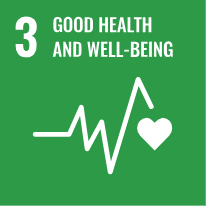
SDG target 3.4
By 2030, reduce by one-third premature mortality from non-communicable diseases through prevention and treatment and promote mental health and well-being.
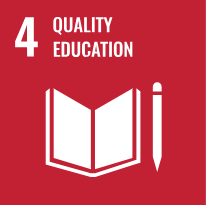
SFG target 4a
By 2030, build and upgrade educational facilities that are child, disability and gender sensitive and provide safe, nonviolent, inclusive and effective learning environments for all.
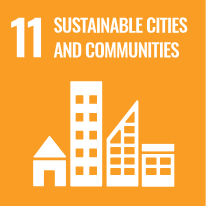
SDG target 11.2
By 2030, provide access to safe, affordable, accessible and sustainable transport systems for all, improving road safety, notably by expanding public transport, with special attention to the needs of those in vulnerable situations, women, children, persons with disabilities and older persons.
SDG target 11.7
By 2030, provide universal access to safe, inclusive and accessible, green and public spaces, particularly for women and children, older persons and persons with disabilities.

SDG target 13.1
Strengthen resilience and adaptive capacity to climate-related hazards and natural disasters in all countries.
SDG target 13.2
Integrate climate change measures into national policies, strategies and planning.
Proposed actions
For all the above reasons, and considering that Spain is one of the countries that ratified the Convention on the Rights of the Child (CRC) (the ratification of the Convention was published in BOE number 313, 31 December 1990), this proposal is presented so that school environments become areas for the protection of children’s health.
In order to achieve this transformation, all the relevant public administrations are urged to work together to implement the following measures:
Replacing car parks on school grounds with playgrounds and play areas.
Provide secure parking for bicycles, skateboards and scooters on or near all school premises to encourage active transport to school.
Revegetate school playgrounds with trees and plants that provide shade, freshness and colour, improve air quality and reduce noise.
access to schools
access to schools
Restrict parking and traffic in the surrounding streets, especially near the entrances to the centres.
Strictly monitor and enforce traffic regulations when students arrive and leave to ensure that the school environment is a safe and friendly place.
Prioritise pedestrian and cyclist mobility on the roads around the school, creating car-free access corridors, encouraging the presence of vegetation and water, and promoting recreation, meeting and play areas in the public space.
Integrate measures to promote a safe and healthy school environment into the drafting of the Municipal Urban Development Plan.
Include specific traffic restriction and traffic calming measures around schools in sustainable urban mobility plans.
Promote widespread adoption of the City 30 model to reduce traffic speeds on all urban roads.
Prioritise proximity to the school centre as a basic criterion for the school area, for the benefit of children and the whole community, reversing the implementation of the ‘single school zone’ which has had such a negative impact on the increase in daily motorised journeys.